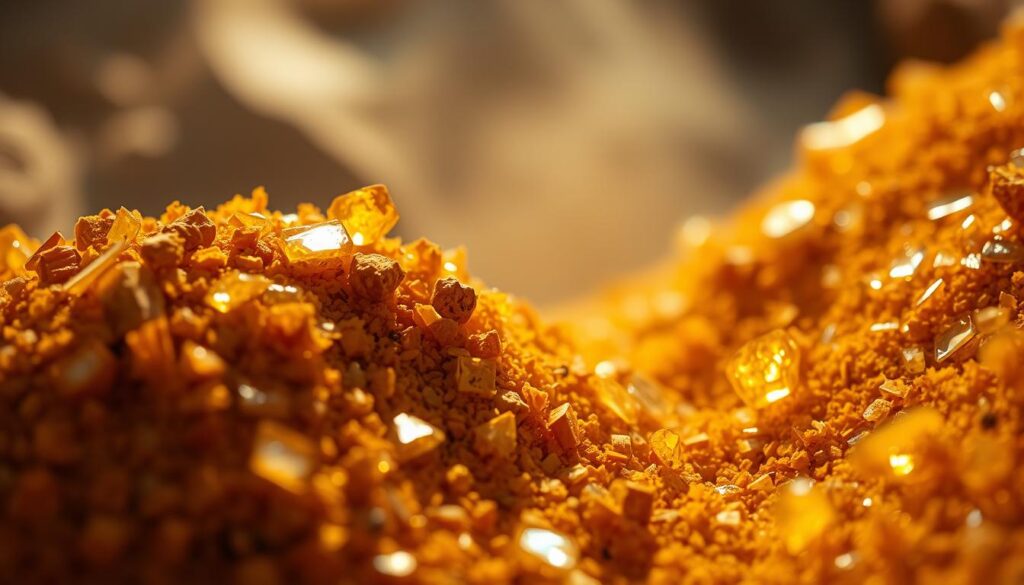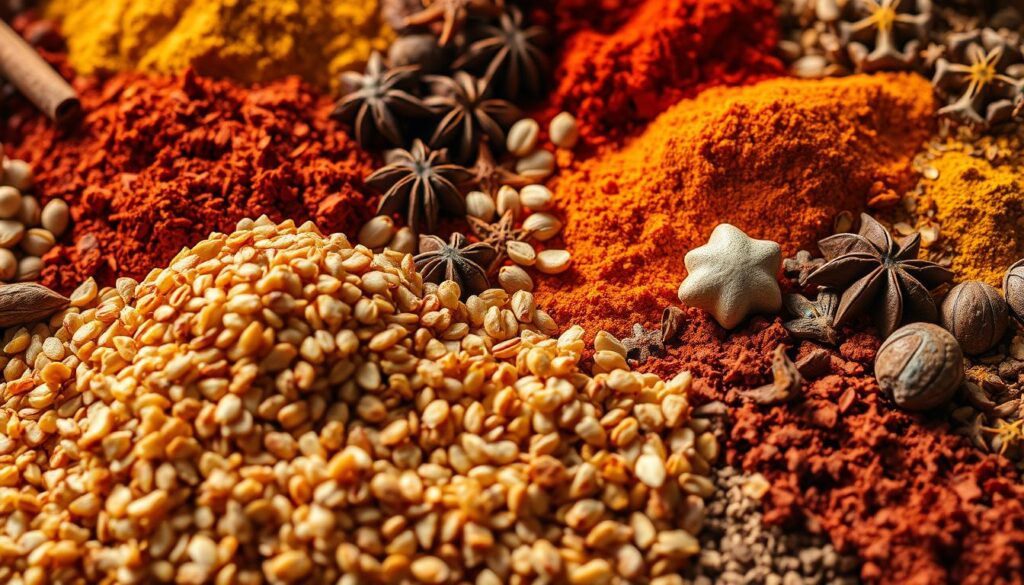We often encounter terms in cooking that have fascinating backstories and multiple layers of meaning. Spice melange is one such term that has captured the imagination of food enthusiasts and science fiction fans alike. Originating from a blend of fictional and real-world culinary influences, spice melange represents a harmonious combination of various spices that work together to create complex flavor profiles.
In the culinary universe, the concept of melange – or mixing different elements to achieve a unique outcome – is not new. Chefs and home cooks have long experimented with blending spices to enhance dishes. By understanding the principles behind spice melange, we can unlock new flavors and elevate our cooking.
Key Takeaways
- Spice melange is a blend of various spices creating complex flavors.
- The concept combines fictional and real culinary influences.
- It represents a harmonious mix of spices enhancing dishes.
- Understanding spice melange can elevate cooking.
- Spice blending is a long-standing culinary practice.
The Dual Nature of Spice Melange
The concept of spice melange has become intertwined with both culinary practices and science fiction, creating a fascinating dual identity. On one hand, it is deeply rooted in the culinary world where blending spices is an art form. On the other hand, it has been significantly influenced by Frank Herbert’s science fiction novel, Dune, where “melange” is a rare and highly valued substance.
Fiction vs. Reality: Separating Dune from the Kitchen
In Dune, melange is a psychedelic drug that extends life and enhances cognitive abilities, making it a central element of the fictional universe. However, in the culinary world, a spice melange refers to a blend of spices used to add depth and complexity to various dishes. While the fictional melange has extraordinary properties, the real spice melange is valued for its flavor and aroma.

| Aspect | Fictional Melange | Culinary Spice Melange |
|---|---|---|
| Purpose | Extends life, enhances cognitive abilities | Adds flavor and aroma to dishes |
| Properties | Psychedelic, highly valued | Varied, depending on spice blend |
| Usage | Consumed for its medicinal properties | Used as a seasoning in cooking |
The Etymology of “Melange” in Culinary Terms
The word “melange” is French, meaning “mix” or “blend.” In culinary terms, it accurately describes a blend of spices. The concept of blending spices predates the science fiction novel, but the popularity of Dune has influenced how some specialty spice blends are marketed and perceived. Today, the term “spice melange” reflects both its culinary heritage and its association with the fictional universe.
By understanding the dual nature of spice melange, we can appreciate both its cultural significance and its practical applications in cooking. Whether in the context of Frank Herbert’s novel or in the kitchen, the essence of melange lies in its ability to enhance and transform.
What is Spice Melange in Culinary Traditions
In the culinary world, spice melange represents a carefully crafted mixture of spices designed to add depth and complexity to food. This blend is not just a random mix of spices; rather, it’s a thoughtful combination that enhances the overall flavor profile of various dishes.
Definition and Basic Composition
Spice melange is defined as a harmonious blend of aromatic spices that work together to create a unified flavor profile. The basic composition typically includes a variety of spices such as cinnamon, cardamom, and cloves, among others. The exact composition can vary greatly depending on the culinary tradition or the specific recipe.
The art of creating a spice melange involves balancing different flavors—sweet, savory, spicy, and aromatic—to achieve a complex yet harmonious taste experience. This balance is crucial for enhancing the flavor of dishes without overpowering them.
Historical Origins of Spice Blends
The use of spice blends dates back thousands of years, with ancient trade routes playing a significant role in the dissemination of spices across different regions. People have been creating melanges for culinary and preservative purposes, leading to a rich diversity of spice blends across cultures.
From the garam masala of India to the ras el hanout of North Africa and the herbes de Provence of France, each region has developed its unique signature spice blends. These blends not only reflect local tastes and preferences but also the historical and cultural contexts of their respective regions.
Cultural Significance Across Different Cuisines
Spice melange has become a cornerstone of culinary identity for many cultures and regions. The specific blend used can evoke traditional flavors and aromas, connecting people to their culinary heritage. Across the universe of global cuisine, the concept of melange has evolved, incorporating local ingredients and reflecting the diversity of culinary practices.
As a substance, spice melange has evolved from a practical method of food preservation to a sophisticated culinary art form. Its significance extends beyond flavor enhancement to represent cultural traditions and regional identities.
| Region | Spice Blend | Common Ingredients |
|---|---|---|
| India | Garam Masala | Cloves, Cardamom, Cinnamon, Black Pepper |
| North Africa | Ras el hanout | Cumin, Coriander, Cinnamon, Ginger, Turmeric |
| France | Herbes de Provence | Thyme, Rosemary, Oregano, Lavender |

Common Components of a Traditional Spice Melange
At the heart of everyspice melangeare a variety of spices that come together to create a complex and aromatic blend. This blend is not just a random mix; it’s a carefully crafted combination of spices, each chosen for its uniquepropertiesandabilitiesto enhance the overall flavor and aroma.
Core Spices and Their Flavor Profiles
The core spices in a traditional spice melange often include cinnamon, cardamom, cloves, nutmeg, and allspice. Cinnamon, with its warm, sweet properties, frequently serves as a central note in many blends, much like in the fictional melange from Dune, where it’s noted for its cinnamon-like odor.
Other key components bring their own unique flavor profiles to the table: cardamom adds a sweet, herbal note; cloves contribute a pungent, slightly bitter taste; nutmeg provides warmth and depth; and allspice brings a blend of cinnamon, nutmeg, and ginger flavors. Together, these spices create a rich and complex substance that can elevate a variety of dishes.
Regional Variations and Unique Ingredients
While the core spices remain relatively consistent, regional variations of spice melange can include unique ingredients based on local preferences and available spices. This diversity results in a wide range of melanges, each with its own character and applications in different cuisines.
Balance and Harmony in Spice Combinations
Achieving balance and harmony is crucial in creating a successful spice blend. The proportions of different spices can dramatically affect the final character of the melange, and subtle adjustments can alter its application in various dishes. By understanding the properties and abilities of each spice, we can craft a melange that enhances a wide range of culinary creations.
Culinary Applications of Spice Melange
The versatility of spice melange is showcased through its numerous applications in global cuisine. We explore how this complex blend of spices enhances various dishes, from traditional recipes to modern culinary innovations.
Traditional Dishes Enhanced by Melange
Spice melange has been a cornerstone in many traditional cuisines, playing a significant role in dishes that have stood the test of time. For instance, in Indian cuisine, a well-crafted melange can elevate a simple curry into a rich and aromatic experience. Similarly, in Middle Eastern cooking, the blend is often used to add depth to stews and kebabs. We examine the use of spice melange in these traditional contexts, highlighting its ability to bring life to various culinary preparations.

Modern Culinary Innovations
Contemporary chefs are reimagining the spice melange in innovative ways, incorporating it into unexpected dishes such as craft cocktails and desserts. This modern twist not only showcases the versatility of melange but also demonstrates its potential to transform familiar flavors into something new and exciting. We highlight some of these modern applications, illustrating how chefs are pushing the boundaries of traditional spice blending.
Pairing Recommendations with Various Foods
Pairing the right spice melange with different foods can significantly enhance the dining experience. We provide specific recommendations for pairing various types of melange with proteins, vegetables, and grains, helping readers understand which blends complement different ingredients best. By choosing the appropriate melange, home cooks can add complexity and satisfaction to their dishes, making even simple meals more enjoyable.
Creating Your Own Spice Melange at Home
With a few simple ingredients and some basic equipment, you can create your own signature spice melange. This process allows you to tailor the flavor profile to your liking and experiment with different culinary traditions.
Essential Ingredients and Equipment
To start, you’ll need a selection of whole spices such as cinnamon, cardamom, and cloves. The quality of your spices will directly impact the flavor of your melange, so choose fresh, aromatic spices. You’ll also need a grinder or spice mill to release the essential oils from the spices, enhancing their flavor and aroma. A mixing bowl and spoon are necessary for combining the ground spices evenly.
Step-by-Step Mixing Process
Begin by toasting your whole spices to bring out their natural oils. This step enhances the depth of flavor in your melange. After toasting, grind the spices to the desired consistency. Some recipes may call for a fine powder, while others may require a coarser texture. Mix the ground spices together thoroughly, ensuring an even distribution of the different components. If needed, add a small amount of water or oil to bind the spices together, especially if you’re creating a melange for a specific culinary application.
Storage and Shelf Life Considerations
To maintain the potency and flavor of your homemade spice melange, store it in a cool, dark place away from moisture and heat. Exposure to these elements, much like in a harsh desert environment, can cause the spices to lose their flavor and aroma more quickly. Properly stored, your spice melange can retain its quality for several months. The key is to minimize exposure to air, light, and moisture, preserving the mass of flavors you’ve carefully blended.
Health Benefits and Nutritional Properties
Beyond its culinary uses, spice melange is recognized for its potential health benefits, rooted in the properties of its constituent spices. The blend, which varies across cultures, typically includes a mix of spices known for their antioxidant, anti-inflammatory, and other beneficial properties.
Potential Wellness Advantages
The spices in melange blends are rich in antioxidants and anti-inflammatory compounds, which may contribute to a longer, healthier life. For instance, spices like turmeric contain curcumin, a compound known for its anti-inflammatory properties.
Traditional Medicinal Uses
Various cultures have valued the spices found in melange for their healing properties. For example, cinnamon has been used in traditional medicine for its potential to help manage blood sugar levels.
Modern Nutritional Perspective
Modern research supports the health benefits of consuming a diverse range of spices. A study on spice consumption suggests that it can enhance cognitive function and may have a positive impact on life span.
| Spice | Antioxidant Capacity | Anti-inflammatory Properties | Cognitive Benefits |
|---|---|---|---|
| Turmeric | High | Yes | Potential |
| Cinnamon | Medium | Yes | Possible |
| Ginger | High | Yes | Potential |
We will discuss how certain spices in melange blends have been associated with cognitive benefits and heightened mental abilities, similar to the fictional spice’s effects on blue eyes and prescience, as depicted in fictional works.
Embracing the Art of Spice Blending in Your Kitchen
Embracing the role of a spice blender opens your eyes to a world of flavors, elevating everyday dishes. We encourage you to experiment with creating your own signature spice melange, guided by personal preferences. Developing an eye for spice blending is both an art and a science, requiring time and practice. This journey connects you to a vast culinary universe, allowing for personal expression. By crafting your own melange, you play a significant role in enhancing the flavor profile, bringing new life to familiar recipes.


